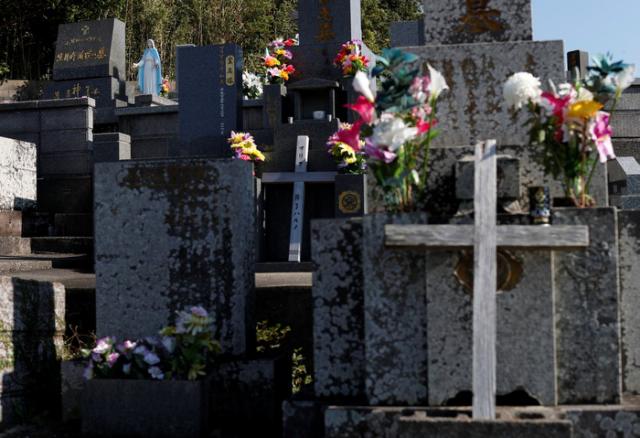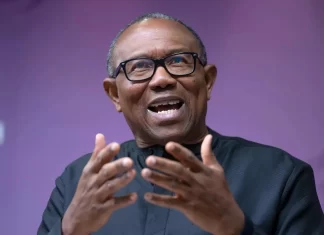By Reuters
His face weathered from years at sea, kimono-clad Japanese fisherman Masaichi Kawasaki kneels before an altar adorned with images of the Virgin Mary, crossing himself as he softly intones chants handed down through centuries.
Kawasaki, 69, is one of a dwindling number of Japan’s “Kakure Kirishitan,” or “Hidden Christians,” descendants of those who preserved their faith in secret during centuries of persecution.
His unique faith blends Buddhist, Christian and Shinto practices, and its ritual chants combine Latin, Portuguese and Japanese.
The Hidden Christians have garnered fresh attention ahead of Pope Francis’s visit to Japan on Nov. 23-26, with domestic media and a French broadcaster heading to Nagasaki to report on them. Last year, 12 Hidden Christian-related locations were designated UNESCO World Heritage sites.
But their religion may be on the verge of extinction as youth leave rural areas, where the faith has persisted.
“I worry that what my ancestors worked hard to preserve will disappear, but that is the trend of the times,” said Kawasaki, who prays each evening at home before the altar, flanked by others devoted to Buddhist and Shinto gods.
“I have a son but I don’t expect him to carry on,” he added. “To think this will disappear is sad, without a doubt.”
CENTURIES OF SUPPRESSION
Jesuits brought Christianity to Japan in 1549, but it was banned in 1614. Missionaries were expelled and the faithful were forced to choose between martyrdom or hiding their religion.
Many joined Buddhist temples or Shinto shrines to disguise their beliefs, and some rites such as confession and communion, which require a priest, disappeared.
Other rituals blended with Buddhist practices such as ancestor worship or indigenous Shinto ceremonies.
Handed down orally and in secret, “orasho” chants – from “oratio” in Latin – combined Latin and Portuguese with Japanese, their meanings mostly symbolic.
When Japan’s ban on Christianity was lifted in 1873, some Hidden Christians joined the Catholic Church; others opted to maintain what they saw as the true faith of their ancestors.
“They didn’t want to destroy the faith they had preserved all along despite suppression,” said Shigenori Murakami, the seventh-generation head of a group of Hidden Christians in Nagasaki City’s Sotome district, the setting for Martin Scorcese’s 2016 movie “Silence” about persecuted Christians.
Pope Francis is expected to speak of Hidden Christians when he visits a martyrs’ monument on Nishizaka Hill in Nagasaki, southwest Japan, where 26 Christians were executed in 1597.
“I think there is a high likelihood that he will send a message about the Hidden Christians,” whom he has mentioned in the past, Kagefumi Ueno, a former Japanese envoy to the Vatican, told reporters. “The pope has said the fact that in Japan there were Christian people who maintained their beliefs for two and a half centuries under great suppression holds a big lesson for the present.”
SHRINKING NUMBERS
Murakami, 69, took over as “chokata,” or leader, of his local believers group after his father died 14 years ago. He spent three years learning the orasho from books based on crumbling 18th century scrolls that he still owns.
On Ikitsuki Island in southwest Japan, where Kawasaki lives, the chants are traditionally spoken and sung. But in Sotome, believers prayed silently for fear of being exposed. Murakami’s father began chanting aloud about 40 years ago at the request of fellow Hidden Christians.
At the time, his father’s group had about 100 people. Now there are only about half that number, Murakami said.
“In my grandfather’s day, there were several hundred,” Murakami said. “But young people are not interested. They are turning away from religion generally.”
Exact numbers of Hidden Christians are hard to come by, but no one disputes their ranks are shrinking. Only around 1% of Japan’s population is Christian.
Shigeo Nakazono, curator at a museum on Ikitsuki Island, said there were probably about 300 believers in four groups there, down from 2,000 in 20 groups three decades ago.
“The future is tough,” said Nakazono, noting that youth were leaving the island, where the mainstay fishing industry is in decline.
A lack of formal leadership to help adapt to changing society is another obstacle to the Hidden Christians’ survival, Nakazono said.
“The old ways are preserved and there is no mechanism to change them in line with social change,” he said.
Murakami, however, said his goal was to keep traditions the way they were.
“I don’t want to change,” he said. “I will continue to do as I have done, cherishing the ways handed down from my forefathers.”
Still, he said he was determined that his religion would not die out.
“I have not picked a successor yet, but I have confidence I can keep going myself and I will surely pass this on,” he told Reuters after an ecumenical ceremony of Hidden Christians, Buddhists and Catholics at the small Karematsu Shrine in Nagasaki, dedicated to a Portuguese priest who died there in the 17th century.
“I cannot let my generation be the ones who destroy what my ancestors protected with their lives.”














